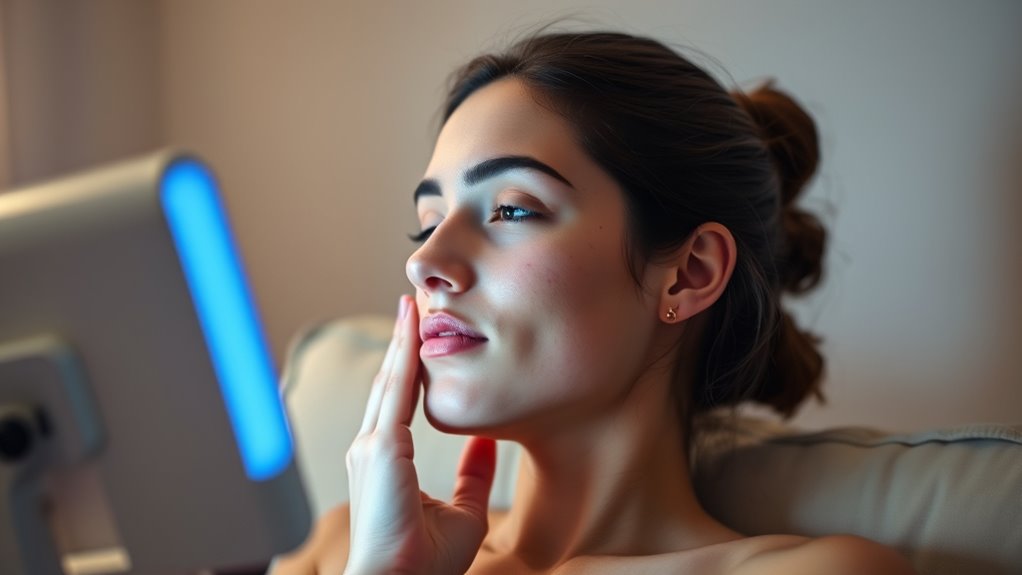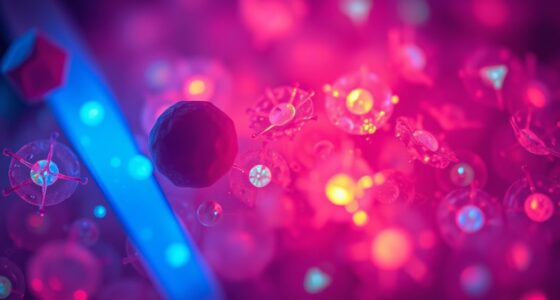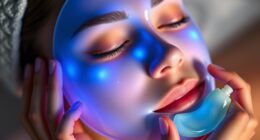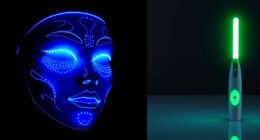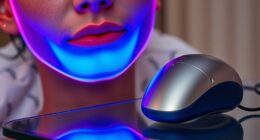Using light therapy during menstrual breakouts can help reduce inflammation and control oil production caused by hormonal fluctuations. Blue light kills bacteria that cause acne, while red light promotes healing and calms skin. Regular use can stabilize your skin’s response, diminishing breakout severity over time. It’s a gentle, non-invasive option that fits into your skincare routine. Keep going, and you’ll discover how combining this treatment with other skincare steps can boost your results.
Key Takeaways
- Light therapy can reduce inflammation and bacteria, helping to manage hormonal breakouts during menstruation.
- Regular use may stabilize skin’s response to hormonal fluctuations, decreasing breakout severity over time.
- Blue light targets acne-causing bacteria, while red light promotes healing and reduces inflammation.
- Combining light therapy with a consistent skincare routine enhances its effectiveness during hormonal cycles.
- Consulting a dermatologist ensures appropriate device selection and safe integration during menstrual-related skin issues.
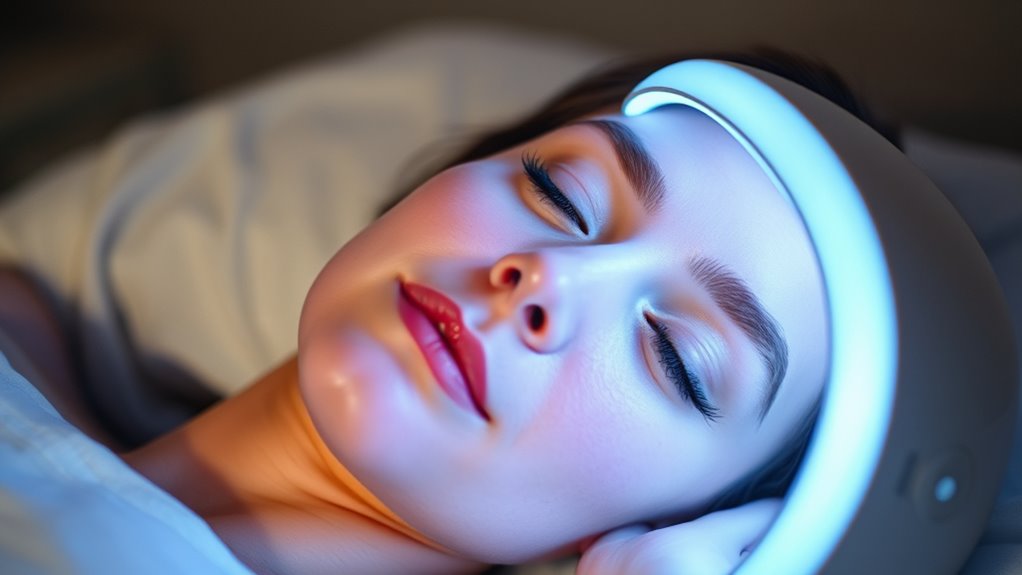
If you’re tired of dealing with breakouts every month around your period, light therapy might offer a promising solution. While it’s commonly associated with skin conditions like acne or psoriasis, recent research suggests that specific wavelengths of light can also help regulate hormonal fluctuations that trigger breakouts during your menstrual cycle. The idea is that light therapy can reduce inflammation, control excess oil production, and promote skin healing—all essential factors in managing hormonal acne linked to your cycle.
During your menstrual cycle, hormone levels fluctuate, especially estrogen and progesterone, which influence oil production and skin sensitivity. These hormonal shifts can lead to increased sebum output, clogged pores, and inflammation, resulting in those frustrating breakouts. Light therapy aims to target these issues directly by penetrating the skin with specific wavelengths, typically red or blue light. Blue light is known for its antibacterial properties, killing acne-causing bacteria, while red light can penetrate deeper to reduce inflammation and promote tissue repair.
Using light therapy regularly might help stabilize your skin’s response to hormonal swings, diminishing the severity and frequency of breakouts. Many devices are designed for at-home use, offering convenience and control over your treatment schedule. You simply need to expose affected areas to the light for a prescribed duration, often a few minutes daily or several times a week. Consistency is key, as the benefits tend to accumulate over time rather than providing instant results.
Although the science is still evolving, some studies indicate that light therapy can influence cellular activity and improve skin barrier function. This means your skin may become less reactive to hormonal changes, reducing the occurrence of breakouts around your period. Plus, because light therapy is non-invasive and free from harsh chemicals, it’s a gentle option suitable for sensitive skin types. It doesn’t come with the risk of side effects like dryness or irritation that sometimes accompany topical treatments.
Furthermore, emerging evidence suggests that combining light therapy with other skin treatments can enhance overall effectiveness and help maintain clearer skin during hormonal fluctuations. However, it’s important to remember that light therapy isn’t a cure-all. It works best as part of a comprehensive skincare routine that includes proper cleansing, moisturizing, and possibly other treatments recommended by your dermatologist. If you’re considering trying it, consult with a skincare professional to determine the right wavelength and device for your skin type and concerns. When used correctly, light therapy can be a safe, effective way to support your skin through hormonal fluctuations, helping you manage those pesky breakouts more confidently each month.
Frequently Asked Questions
Can Light Therapy Prevent Future Menstrual Breakouts?
Light therapy can help reduce the severity of future menstrual breakouts by targeting inflammation and bacteria on your skin. While it may not entirely prevent breakouts, regular sessions can improve your skin’s overall health and lessen their frequency. You should combine light therapy with a consistent skincare routine and healthy habits for the best results. Remember, individual responses vary, so consult a dermatologist for personalized advice.
How Often Should I Use Light Therapy During My Cycle?
You should use light therapy daily during your cycle, ideally starting a few days before your period begins and continuing through the first few days of menstruation. Consistency is key, so stick to a routine that fits your schedule. Use the therapy for about 10-15 minutes each session, and adjust as needed based on how your skin responds. Regular use can help manage breakouts and improve overall skin health.
Are There Any Side Effects From Light Therapy?
You might experience mild side effects from light therapy, like eye strain, headaches, or skin irritation, especially if you’re sensitive or don’t follow safety guidelines. To minimize risks, use the device as directed, wear protective eyewear, and avoid overuse. If you notice persistent discomfort or skin problems, stop treatment and consult a healthcare professional. Generally, side effects are rare and temporary when you follow proper procedures.
Is Light Therapy Effective for Hormonal Acne?
Imagine your skin as a garden, and hormonal acne as stubborn weeds. Light therapy acts like sunlight, helping to weaken these weeds and encourage healthier growth. It can be effective for hormonal acne, reducing inflammation and bacteria that cause breakouts. While it may not erase every weed instantly, regular treatments can bring noticeable improvement, making your skin clearer and your garden more vibrant.
Can Teenagers Safely Use Light Therapy for Breakouts?
Yes, teenagers can safely use light therapy for breakouts, but you should consult a dermatologist first. Light therapy is generally non-invasive and safe when used correctly. Make sure to adhere to the recommended guidelines and avoid overusing it. It’s important to get professional advice to determine the right type of light therapy for your skin and ensure you’re using it safely to see the best results.
Conclusion
So, if you’re struggling with pesky menstrual breakouts, give light therapy a shot. It’s a simple, soothing solution that can shine a spotlight on clearer, calmer skin. With consistent care, you can combat breakouts and boost your confidence. Don’t let hormonal havoc hold you hostage—harness the healing power of light, and watch your skin soften, soothe, and shine. Embrace this easy, effective option and say goodbye to blemishes with brightness!
